
Tamiya 1/16th scale radio controlled M4 Sherman tank
Review date: 14 September 1999. Last modified 15-May-2014.
Model tanks are, on the face of it, a cool idea.
Re-enact your favourite scenes from A Bridge Too Far, or Saving Private Ryan, or The Beast, or for that matter Kelly's Heroes, in your back yard! Crush your Matchbox cars! Tow a beer trailer! Et cetera!
Unfortunately, the reality of model tanks has often been disappointing. There are little cheap prebuilt ones with rubber tracks that have a hard time negotiating anything but carpet, and there are huge prebuilt ones two people can't carry that cost more than a quite nice car. And then there are build-them-yourself kits made by Tamiya.
Tamiya is arguably the best scale hobby model company in the world, and they've been making 1/16th scale R/C tanks, on and off, for ages. Tamiya make a lot of R/C gear that may not be as fast or as tough as other options, but looks so much like the real thing that only the antenna and the body clips give the game away. Install an under-body antenna and Velcro or some other hidden body-mounting method and a Tamiya model can be spookily realistic.
As gorgeous display models with some mobility, the Tamiya tanks were always pretty cool. But their (perfectly scale) tracks were known for fragility, and their drive system was nothing special. It used a single 540 motor (the same plastic-endbell thin-can 27 turn single wind motor used in umpteen cordless power tools) and a quite complex dual-clutch-and-brake transmission that allows the one motor to drive either track, or both. The complex transmission robs power, the motor speed controller is a jerky three-step mechanical job, and the design doesn't let both tracks turn in opposite directions, for pirouette turns; the best it can manage is stopping one track and driving the other. This, of course, is also the best that most real tanks can manage, but the heck with that; why not get better from your model!
And so the only option for someone who wanted a durable toy tank was one of the large-scale monsters. These big boys usually come from Italy or Russia or similar homes of skilled artisans and unpopular armies. But large scale tanks, while good, are not just impractically huge (three feet long!), but also stupidly expensive. You can get a reasonable used BMW for the price of a large scale gas powered Tiger tank. It'll impress the heck out of your friends, which is good because you'll probably need a couple of them to help you get it out of the car, but it's nonetheless not a sensible toy. Large scale tanks are well over the sanity line.
The obvious solution for flexible track drive is dual motors, one driving each track, but that's not as simple as it seems. You might think you could just have independent throttle control for each track, and two fore-and-aft joysticks for control, one for each side. But this makes it close to impossible to drive straight at less than full speed, and also means you need a special radio; two-stick two-channel R/C transmitters are common and cheap, but none of them come stock with both sticks set for fore-and-aft operation, and most cheapies can't have their sticks rotated.
Tamiya have, finally, solved the problem with their T-01 Dual Motor Drive (DMD) Control Unit, a handy-dandy combination signal mixer and twin motor speed control that lets a plain two channel radio drive a tank. The new speed controller comes as part of their current tank kits, and it makes them a real option. They're still not cheap, but they're far cheaper than large scale tanks. So I bought one - an M4 Sherman.
What you'll pay
The base Sherman kit is about $900 (Australian dollars). Never mind the price, feel the quality.
On top of the kit, you'll need a radio, at least one battery, a charger for the battery, a few basic tools and some glue. You only need a plain two channel radio, which is less than $100 Australian for transmitter and receiver; I got a fancy five channel model so I could play with other features, like motorising the turret, later. Plain 1700 milliamp-hour (mAh) nickel-cadmium (NiCd) battery packs cost about $AU50 each, a decent "smart" peak detecting charger will run another $AU125 or so (a dumb timer charger will cost you well under $AU50, but it's false economy; your battery packs won't thank you).
If you want to do the full-blown scale version, you'll also need a few tins of paint and a bit more patience.
Building it
Like most "serious" R/C toys, the Sherman comes as a box of bits. Putting it together is, if not half the fun, then still some large slice of it. The drive gearboxes are pre-assembled, but pretty much everything else has to be screwed, slotted and glued together by you.
The manual for the Sherman is considerably thinner than the instructions for a lot of other Tamiya kits, but that's because it frequently says things like "repeat 12 times" or "make 6" or, in the case of the tracks, "do this 76 times, then do the other track".
The tank as a whole is not actually a terribly challenging thing to build, but it's not for little kids. The tracks, in particular, are a bit annoying to assemble, and might frustrate beginners. If you've ever considered making a chain mail vest, consider this practice. It'll take you more than two hours per track, just for them; I suggest doing it in front of the TV, unless you enjoy Zen for obsessive-compulsives. Hemostats (locking "scissor pliers", mentioned in my tools article here) make assembling the track links considerably easier, since they let you pinch the springy centre piece together while you snap on the treads on either side; without something to pinch the centre piece, I don't know how you could assemble the tracks at all.
Once the tracks are done, though, they're worth it; all steel, nice and supple, and satisfyingly heavy. Sling both tracks over your shoulder and you'll feel like Worf from Star Trek.
The rest of the assembly is less of a pain, especially if, like me, you chicken out and leave all of the super-scale stuff in the box. Tamiya provide a plethora of little plastic lights, tools, tow loops and other accoutrements for the tank, including a finely detailed (but, apparently, not quite right) machine gun for the top of the turret. If you want the tank as a display model, all of this stuff is great, but if you're going to bash it around the garden, most of the trimmings won't last long.
To make the trimmings look decent, you'll have to paint them all appropriate colours (the instructions helpfully indicate the exact Tamiya paint colours you can use), which is considerably more effort than I cared to expend. All of the plastic parts are dark olive if left unpainted, which is fine with me; sure, there were lots of shiny aluminium bits visible on my unpainted tank, but since I aimed to turn the whole thing an honest mud-brown, I can't say I cared.
The instructions, as for all Tamiya kits, are superb. The parts all fit together the way they're supposed to - the track links are a bit stiff, but manageable - and it's pretty hard to screw anything up. Some R/C kits have parts that don't match the instructions, or haven't been made properly, but Tamiya kits never do. And, like all good model companies, Tamiya include a few spare screws and washers, to take into account the fact that such components tend to leap into a parallel universe at the first opportunity.
The only thing the Tamiya instructions don't tell you to do is use threadlock. For fuel-powered R/C cars, which all have single cylinder engines specially made to shake themselves apart, threadlock on every screw is a must. For the electric powered tank it's not such a big deal, but I nonetheless dabbed blue Loctite onto every metal-to-metal screw thread, on general principles. The stuff is cheap, and screws that back out are a pain. I also found a few places to squirt some of Tamiya's own distinctively sweet-smelling blue threadlock; you shouldn't use Loctite (or the generically branded equivalent) where screws thread into plastic, but the Tamiya goop (which comes out of the tube in only two quantities - too much, and far too much) still works.
Incidentally, the turret can rotate and the gun can elevate, but they're not powered - you move them by hand. There's plenty of room inside the chassis, though, and a servo-driven turret drive was my first enhancement to the kit - see below!
Power
The T-01 DMD Control Unit is a clever little piece of gear. Much larger than most electronic speed controllers but not much heavier, its circuit board packs a Motorola microcontroller, an interesting undocumented "Mode" switch and a total of ten header pins which no doubt also have some interesting function. It's probably made to work in future robotics kits as well as straight R/C.
The T-01's speed controller circuitry has a high drive frequency. Electronic speed controls use pulse width modulation to vary motor power, and the faster they switch the current the gentler they are to the motors they're connected to. The Sherman's motors, at less than full power, sing the distinctive high note of a quality controller.
People have made twin-motor R/C setups before, either by using a third party skid-steer controller (like the ones made by Vantec and 4QD, which have far higher power capacity than the little Tamiya) or by using a fancy computerised radio with programmable channel mixing, and a pair of plain speed controllers. The Tamiya controller might not have the grunt of its older competition, but it's just as smart; it adjusts track speed and direction to seamlessly transition from forward or backward to gentle turning (stopping one track and driving the other faster) to pirouetting (driving both tracks in opposite directions). This makes the control system very straightforward.
The Sherman is powered by a standard six cell "stick pack", but the chassis is roomy enough that you could mount a variety of different battery configurations. I don't know how happy the T-01 would be about more than six cells. It's got an automatic low voltage cut-out that will prevent it from working properly on fewer cells. On one 1700mAh pack, it runs for about 15 minutes of quite aggressive driving.
The only possible shortcoming of the Sherman's drive system is that the motors don't have any RF noise suppression capacitors installed. Brush motors spark a lot, and that can cause radio glitches, especially at longer ranges. If you pick a cheap AM radio (as opposed to the all-bells-and-whistles digital FM job I picked), it'd be wise to solder a .01 microfarad ceramic disc cap across the leads of each motor as close to the brushes as you can, and another one from each lead to the motor case. I plan to do it myself, shortly.
How fast does it go?
Ah, Standard Radio Control Question Number 1. And the answer, in this case, is: not very. The twin 380 motors have to work hard just to turn the tracks, which they can do at the rate of about 10 full rotations every 6.5 seconds, when unloaded. Since the tracks are 750mm long, this translates to a road speed of 4.15 kilometres an hour (2.6mph), or a tad less in the real world. Maybe a bit more, with the tracks set loose; the back idler wheel can be adjusted fore and aft to tweak the track tension, and accommodate any stretching over time.
Four kilometres per hour is actually better-than-scale speed; the full sized Sherman had a 450 horsepower V8, but its top speed was only 42 kilometres an hour. The scale speed of the 1/16th scale Sherman - the speed it would travel, if it were full sized and covered a distance equal to its own length in the same time as the model does - is about 65km/h. Then again, the full sized version had a 160 kilometre (100 mile) range; you'd be lucky to cover 600 metres on one 1700mAh battery pack with the model.
Although the top speed doesn't seem tremendously exciting - you can get R/C off-roaders pre-built for half the Sherman's price that do something like ten times the speed - the tank is nonetheless a lot of fun to drive. And lower speed is actually a good thing for an indoor toy; you can buzz the Sherman around the house or office with ease, and not worry about handing the transmitter to your uncoordinated friends; a wheeled road rocket has a hard time avoiding skirting boards, desk legs and hapless human ankles, but a bumbling Sherman driver isn't going to make many enemies.
I, for one, would rather like to see a Tamiya tank racing class. R/C races are run on time, not distance (whoever's done the most laps in four or five minutes wins) so you could actually slot them right into the program, if you had enough entrants. No fair mounting flamethrowers, unless previously agreed.
The Sherman is also tailor-made for rule abuse at meets that have an "anything by Tamiya that isn't a monster truck" race, or a run-what-you-brung novice class. Sure, you won't be able to catch the other racers, but there's nothing stopping you from parking sideways on the hairpin and seeing what happens.
Driveline durability
The problem with tracks, both in scale models and full-sized vehicles, is that they're a real maintenance adventure. If your tracked vehicle only cruises around on clean surfaces then all is well, but in most cases this means it might as well not have tracks at all. Sticks and stones most definitely can break the bones of a track-drive system, if they get jammed between the track and a sprocket.
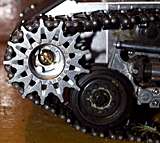
The left track's drive sprocket.
The screw can be covered with
yet another piece of scale
plastic, but I opted not to.
It'd look dumb unless I painted
the sprocket, as the instructions command.
If your tracks are elastic, then a foreign object can be fed around the sprocket and fall out on the other side without damaging anything. Unfortunately, the leeway given by elastic tracks also means that good-sized foreign objects may cause the track to hop completely off the sprocket, a condition known as "throwing a track". When real tanks throw a track, they turn into a bunker, because very few of them can directly drive their road wheels - the engine only drives the sprocket, up there off the ground at one end. When model tanks do it, there's less danger and expense, but a similar amount of cursing.
If you use non-elastic tracks, as the little Tamiya does, then a rock or stick of sufficient size between the track and the sprocket can jam the track completely. It's impossible for the small amount of "stretch" available by tensioning the track (and retracting the little Sherman's very realistic spring-loaded dual-wheel oscillating bogie suspension) to allow the foreign object to make it around the sprocket. If you notice the problem, back up a tad and remove the jamming object, you'll be fine, but if you just bull ahead - as you're likely to do, sooner or later, even if you're very nervously observant - then you're going to exceed the capabilities of the drive system, one way or another.
Ideally, you'd want the drive system to just give up when it's jammed, so one motor simply hums unhappily and no harm is done. Unfortunately, one of the properties of ordinary DC brush motors such as the Sherman's 380s is that the closer their speed is to zero revolutions per minute, the more torque they produce. Brush motors are at their ballsiest when they're stalled.
A "slipper clutch" that can only transfer a limited amount of torque would solve this problem (many electric R/C cars have such clutches, made from two friction pads pushed together with an adjustable spring, to reduce wheelspin and gear wear), but there isn't such an item in the Tamiya tank's drivetrain. A current limiter in the speed controller does the same job, and the control unit does seem to have one - jam the tracks and the motors seem to pull rather less hard than I'd expect them to, from 7.2 volts, which means they should at least be incapable of stripping the gears. But they still try pretty darn hard.
Even with somewhat reduced maximum power, the little 380 motors in the 1/16th Sherman are more than capable of doing mischief to the drivetrain. They may be small, but they've got 30:1 gear reduction. It wasn't long before I discovered the Sherman's drive failure mode, while trundling the tank around some, ah, advanced terrain, replete with eucalypt twigs. The tank lost drive on the right hand track at one point, then got it back, but made a nasty clicking sound. The right drive sprocket had crunched a stick, and was bent back a few degrees, so it could no longer correctly engage the track. It was actually a pretty cool sight - wounded Cavalry unit limps back to base after taking mine damage, and all that - but I could have done without it.
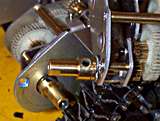
The sprocket outdrives of
the two gearboxes (one
dismounted), showing
the set screws
Removing the right gearbox revealed the cause of the problem; under the high stress of the jammed sprocket, the end of the drive shaft had backed out a bit. The drive shaft ends are held on with a 3mm set screw. Set (or "grub") screws are a notoriously lousy way of holding anything onto anything else, because they invariably gouge the shaft they're tightened onto when under strain, and loosen off. But in this case their unreliability is an asset; the setscrew slipped, the end of the driveshaft could angle back, and the strain was relieved. Shoving the sprocket outdrive back onto the shaft so there was no give left in its mount and re-tightening the set screw solved the problem.
Given the other possible failure modes - torn tracks, stripped transmission gears, detonated speed controllers - I think the Sherman scores very well in this department.
Mucking it about
Oh, come on. You didn't think I'd leave it stock, did you?
Lots of LEDS, a remote switch and a couple of servos make the inside of the body rather more complex than it used to be.
First priority was turret traverse and gun elevation. I didn't manage to pack as much into the turret as did this Japanese lunatic, but at least my harmless non-shooting turret can move menacingly.
A piece of aluminium strip (held in place, surprisingly well, by double-sided tape) crosses the turret hole, and in the middle of the turret is a plain servo, modified for continuous operation according to the instructions found, among other places, here.
An ordinary star-shaped servo horn assembly with de-pointed nails driven through its end holes engages the aluminium crossbar, while still allowing the turret to be easily removed, and also allowing Dan The Uncoordinated Engineer to install the servo without paying any attention to its vertical orientation.
On the side of the normal sized rotation servo is a teeny little Hitec HS-50 micro-servo, for the gun elevation.

There's a simple peg stuck onto the pivoted gun base, and secured against bending with a plate across the base with a hole in the middle.
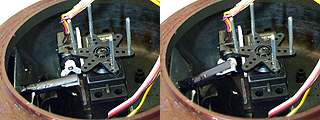
There's a slot in the end of the peg, and the HS-50 has another tack driven through its cute little horn to engage the slot.
The two servos, and the turret lights (of which more in a moment...), have wires that dangle out of the turret, and thus get twisted if you rotate the turret continuously in one direction. I might implement a slip ring arrangement to get rid of this ugliness, one day.
Ah yes. The lights.
White LEDs, to use a technical term, kick arse. They are surprisingly bright. And my Sherman now wears eight of them - four 5mm from Oatley Electronics here in Australia (only four Australian bucks each!), and four 10mm from Hosfelt Electronics in Ohio. Between them, they make the tank brighter than a good penlight. Four high intensity red LEDs serve as totally non-scale tail lights.
The 5mm white LEDs I just wired in sets of two in series, with no current limiting resistor; they run at about 30mA from this voltage, which is uncomfortably high for them and will probably cause them to lose brightness sooner or later. The 10mm ones, and the lower voltage tail lights, I took pity on and gave a resistor to keep them at about 20mA.
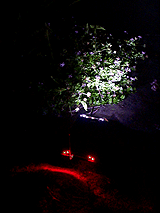
Animated GIF of swivelling lights
You can find more information about high intensity LEDs here.
I remotely switch the LEDs with a Robbe Monoswitch, a simple radio-controlled single pole relay. A Monoswitch is the easy but expensive way to switch things; I could instead have used one of the similar solid state switches my mate Dan Danknick sells here for around the $US20 mark, or an old servo pushing the bar of a microswitch for even less.
With the switch and the two extra servos, I've used all five channels on my receiver.
The colour, by the way, is a couple of coats of cherry metallic over the plain green plastic, with a couple of coats of clear on top. The result is a nifty sort of rusty-blood hue, and arguably the worst jungle camouflage ever created. I also added a few of the scale trimmings - shovel, sledgehammer and so on - done in metallic black. What with the paint job, and the lights, this is definitely a vehicle which would meet with the approval of Oddball (Donald Sutherland), from Kelly's Heroes.
Quote: "A Sherman can give you a very nice edge."
Overall
Frankly, geek toys don't come much better than this. Most proper R/C cars are too fast to run indoors, but the Sherman is as at home on the office carpet as it is grinding through the bark mulch in the local park. And the roomy chassis, with all of that space freed up by the high-tech motor controller, leaves lots of space for super-capacity battery packs or turret servos or water squirters or video transmission gear or whatever other outlandish equipment you might want to jam into your tracked toy.
In fact, the only question for the eager tank-buyer-to-be is whether you can actually get yourself a Sherman. Tamiya have released them as a limited edition, along with a similarly excellent model of the King Tiger to the same scale (with pre-assembled resin tracks instead of the Sherman's build-them-yourself steel ones, but the exact same drive system). The most recent release in the series is a 1/25th scale Panther tank, with 280 motors and a lower-power version of the DMD controller.
I don't think it's at all likely that Tamiya are going to stop making tanks based on the DMD controller. They're probably just going to make various different models. This could present a significant risk to anyone with a propensity to Collect The Set. But it sure beats Franklin Mint pewter pepperpots.
Go on. Buy yourself a tank. You know you want to.
Update: Breaking it, and fixing it
After a bit of driving, I found the Tamiya Sherman's weakness.
The gearboxes.
The final drive axles come under a lot of stress when the sprockets jam. The track pulls backwards on the drive axles all the time, anyway, but the pull's really strong when the sprocket's trying to digest a blockage. This is what causes the abovementioned setscrew slippage.
Do it enough times, though, and the repeated stress buggers the bearings that support the drive axles.
The result is a drive axle that can do this:
They can actually wobble around a bit even when they're new, because they're only supported directly by a bearing at the inside end. The outside end is held firm when the outdrive's attached; a flange on the outdrive sits snugly in the larger outside bearing of the gearbox.
I use the word "bearing" fairly loosely here, though, because these things are not very good bearings.
Here one is, after being sufficiently punished that the outdrive doesn't seat snugly in it any more.
It's not a solid ring of metal, it's a split ring, and it can warp and twist and generally go all manky. Fine for a carpet model, no good for off-road Serious Fun.
Things get even worse if the outdrive setscrew slips, because now the outdrive's slid out along the shaft and the axle's tilted backwards and the split ring is being punished by a small high-stress contact with however much outdrive still touches it and the gears are meshing all wrong and the small, weak, split ring inside bearing's being hauled on and the whole gearbox can, and does, bend.
Which is what happened to my Sherman, after an afternoon of doing laps at a model car dirt track.
"Laps" in this case being defined as "driving over the track, its turf-covered infield, and the steep transitions between the two, in whatever darn directions I chose".
You can buy the gearboxes, complete with motors, as a spare part (this is a proper R/C toy; you can buy the entire kit as spares if you like). So I got a couple of new ones, to save myself from beating the original ones into shape prior to removing the drive axles and fitting something more resilient. A couple of nice little flanged ballraced bearings, by preference.
A certain amount of precision boring-out of holes would be called for. But one suffers for one's art.
One of ze new gearboxes.
But something... something is not the same...
The plot thickens. The shiny new outdrive sitting in the sprocket on the right lacks the flange extension of the old grotty one on the left. It wouldn't work at all if attached to one of the old gearboxes, because it's got nothing to sit inside the split-ring bearing. The unsupported shaft would just flop around.
Here's the explanation. The new gearboxes come with a ballraced drive axle. Little flanged bearings, just like I was going to retrofit, installed as standard.
It would appear that this is Tamiya's apology for the lousy stock gear.
Apology accepted.
With the good new bearings, the drive axle is always supported properly, even if the outdrive falls off completely. The gearbox metal's no stronger and so it could still bend if badly mistreated, but with only slightly more careful driving, this new setup ought to last well.
The nose of the tank, with the bow plate removed and the not-yet-greased gearboxes on show. Tasty.
And then, there's this
The disease progressed.
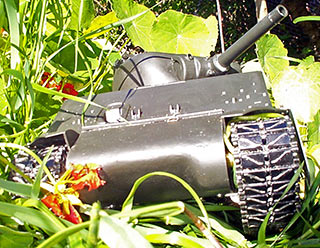

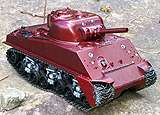
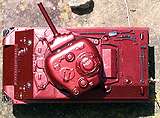
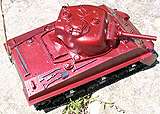
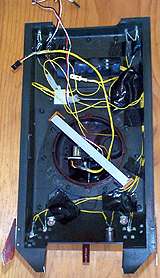
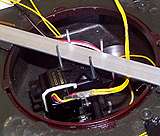
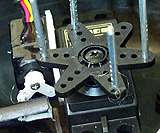
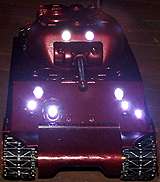

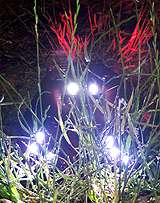
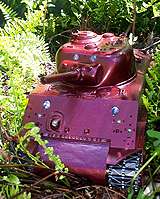
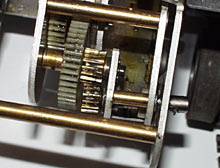
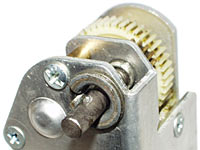
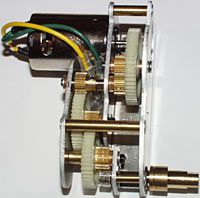





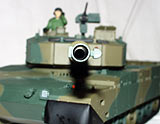

![[SecureWebs]](images/sw.gif)